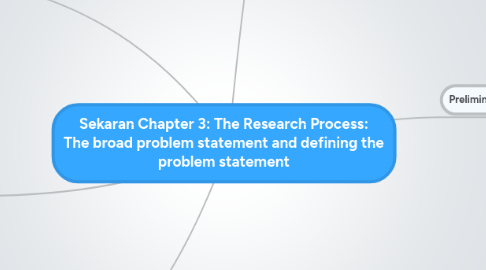
1. Defining the Problem Statement
1.1. Good Problem Statement
1.1.1. Relevant
1.1.1.1. Managerial Perspective
1.1.1.1.1. Relates to a problem in the organization
1.1.1.1.2. Relates to an area the manager believes can be improved
1.1.1.2. Academic Perspective
1.1.1.2.1. Nothing is known about the topic
1.1.1.2.2. There is knowledge about the topic but it is scattered and not integrated
1.1.1.2.3. Much research is available but the findings are (partly) contradictory
1.1.1.2.4. Established relationships do not hold in certain situations
1.1.2. Feasible
1.1.3. Interesting to you
2. The Research Proposal
3. Managers must stay involved throughout the entire research process
4. Preliminary Information Gathering
4.1. Prevailing knowledge on the topic
4.1.1. Literature Review
4.1.1.1. Ensures that
4.1.1.1.1. Important variables are not left out
4.1.1.1.2. you have the right theoretical framework
4.1.1.1.3. you have a precise and clear problem statement
4.1.1.1.4. testability and replicability are enhanced
4.1.1.1.5. you don't rediscover things
4.1.1.1.6. the problem investigated is considered relevant and significant by the scientific community
4.1.1.2. Data Sources
4.1.1.2.1. Textbooks
4.1.1.2.2. Journals
4.1.1.2.3. Theses
4.1.1.2.4. Conference Proceedings
4.1.1.2.5. Unpublished Manuscripts
4.1.1.2.6. Reports
4.1.1.2.7. Newspapers
4.1.1.2.8. Internet
4.1.1.3. Searching for Literature
4.1.1.3.1. Go to your library!
4.1.1.4. Evaluating the Literature
4.1.1.4.1. Look at
4.1.1.4.2. You need to include references to key studies!
4.1.1.4.3. Assess value by
4.1.1.5. Documenting the Literature Review
4.1.1.5.1. Important

